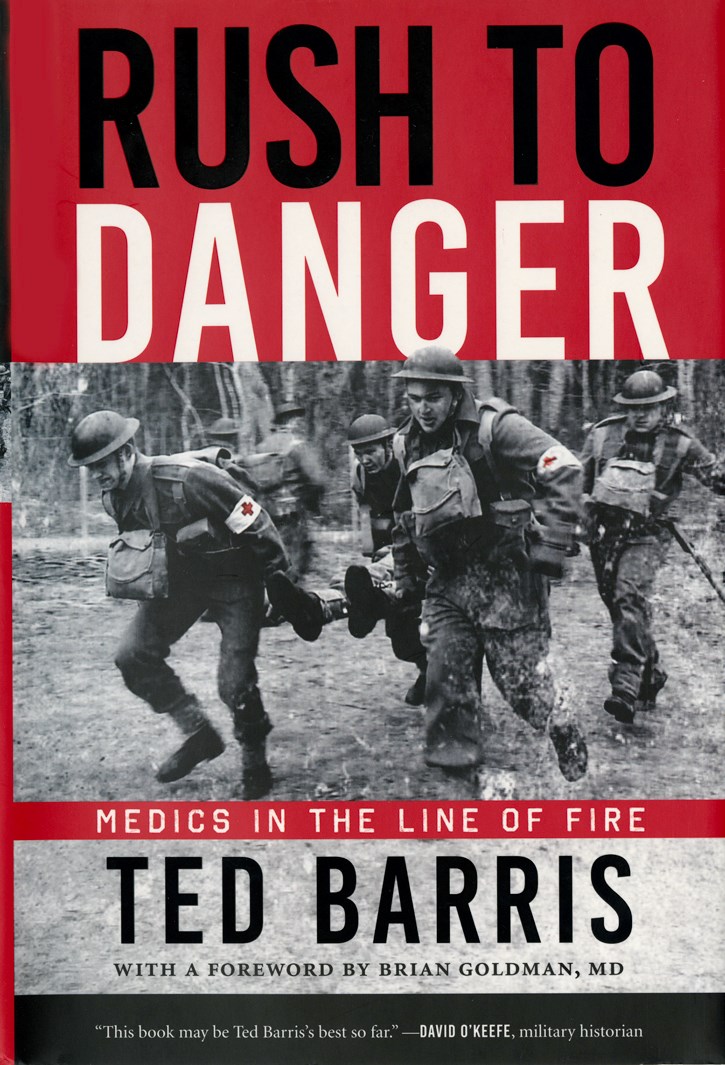In February 1945, during the Battle of the Bulge, Sgt. Alex Barris, a 22-year-old medic with the U.S. 94th Infantry Division, set off alone across a snow-covered and heavily mined field, into a forest littered with booby-traps to find four stretcher bearers who had gone missing.
After finding the four young men and leading them to safety, Alex earned the U.S. Bronze Star for meritorious service. While understandably proud of his father, Canadian author, journalist and broadcaster Ted Barris couldn’t help but wonder what made his father rush so willingly towards danger to save those men despite the risk.
It’s a question that led to his latest book, Rush to Danger: Medics in the Line of Fire.
“I kept asking . . . how he could have accomplished such a mission and survived,” writes Barris, adding that “why” is the more relevant question.
“Why, against better judgement to stay within the safety of friendly lines, would my father instead choose to pick his way through a snow-covered minefield and into a forest infested with booby traps, find those wounded and dazed young litter-bearers, and bring them safely back? Why, when all the world was dashing the other way, would he choose to rush to danger?”
Rush to Danger is Barris’s search for the answer to that question. It was a search that led him to explore his father’s story and of the stories of medical personnel who, like Alex Barris, put their lives at risk to help others on battlefields in Asia, Canada, Europe, the Middle East and the U.S.
Rather than separate the stories into a series of biographies either arranged alphabetically or by date, which is usually how a book of this nature is organized, Barris chose to weave the stories into his father’s story.
Barris, the author of 19 books, 12 about military history, is a master of the transition, and he’s able to travel logically and unerringly from one story to the next without faltering. In one example, he jumps from medics evacuating and treating a wounded Canadian soldier in Afghanistan in 2007 to the creation of the first field ambulance corps in 1862 during the Civil War.
From the Civil War, he moves on to the Second World War and then to the First World War before going back to the Second World War while keeping his story smooth and clear and with his focus firmly on individuals, rather than the wars or specific battles.
The stories Barris chose to tell can be loosely grouped into two categories: innovation and dedication to service.
Among the individuals he highlights for their devotion to duty and to their patients were Lt.-Col. John McCrae, the Canadian author of In Flanders Fields; British nurse Edith Cavell, who was executed by German soldiers in 1915 for helping some 200 soldiers escape Germany-occupied Belgium; Sarah Emma Edmonds, a Canadian who posed as a man, Franklin Flint Thompson, in order to serve as a nurse, a soldier and a Federal Army spy during the U.S. Civil War; and American medical officer, Capt. David Wilsey who was among the first to experience the horror of Dachau, a concentration camp located near Munich, Germany.
For good measure, as part of the stories about the human touch, Barris also includes the story of Princess Louise, an Italian pony rescued and nursed back to health by medics with the Canadian armoured regiment the 8th Princess Louise’s (New Brunswick) Hussars. Princess Louise quickly became the regiment’s mascot.
The innovators, meanwhile, included Jonathan Letterman, who in 1862 developed the concept of a dedicated field ambulance; Herbert S. Birkett (and others, including John McCrae) and the creation of a field hospital, the No. 3 Canadian General Hospital; and Cluny Macpherson, a Newfoundland medical officer who in 1915 designed the British gas helmet.
Barris, whose other books include The Great Escape: A Canadian Story and Dam Busters: A Canadian Story, is an able writer and researcher. He’s also curious, kind and personable, which is reflected in Rush to Danger.
It is, as a result, an enlightening and sensitive book, especially given that some of his subject matter is difficult material. But he clearly took great care in telling the stories of the people he chose, especially as many of the stories are quite personal. It’s easy to see that Barris takes great pride, certainly in his father, but all of people he profiled, as well.
Most importantly, Barris offers an answer to what that mystifying question (and anyone with a veteran who served in war as a doctor, medic or nurse has likely asked the same questions): why did Alex Barris rush towards danger?
The answer, as Barris comes to realize, is quite simple: his father rushed to danger because that was what was expected of him.
“While others in the heat of combat on the front line might ultimately choose to flee from the perceived or real danger,” he writes, “it was his duty and moral obligation to rush toward it. His story – and the stories of those men and women who choose to meet that lethal challenge – deserve to be remembered.”
Rush to Danger: Medics in the Line of Fire by Ted Barris is published by HarpersCollins Publishers. It is available for $32.99.




